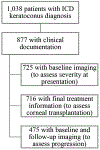Socioeconomic Correlates of Keratoconus Severity and Progression
- PMID: 35184126
- PMCID: PMC10738272
- DOI: 10.1097/ICO.0000000000002993
Socioeconomic Correlates of Keratoconus Severity and Progression
Abstract
Purpose: The purpose of this study was to investigate the social determinants of health for keratoconus.
Methods: In this retrospective cohort study of patients with keratoconus, the electronic health record was reviewed for keratometry, treatments received, clinical comorbidities, and social characteristics. Outcomes included severe keratoconus at presentation (steep keratometry ≥52 diopters), disease progression (≥0.75 diopters increase from the first to the most recent clinical visit), and corneal transplantation. Logistic regression was used to evaluate factors associated with severity at presentation and corneal transplantation. Cox proportional hazards modeling was used to evaluate progression.
Results: A total of 1038 patients with keratoconus were identified, 725 (70%) of whom had baseline imaging. Compared with commercially insured patients, Medicaid recipients were more likely to have severe keratoconus, independent of social and clinical confounders [odds ratio (OR) 1.94, 95% confidence interval (CI), 1.12-3.35, P = 0.017]. Male sex was independently associated with progression (hazard ratio = 1.38, 95% CI, 1.03-1.84, P = 0.030). Medicare and Medicaid recipients were more likely to require transplantation compared with commercially insured patients (OR 2.71, 95% CI, 1.65-4.46, P < 0.001 and OR 1.74, 95% CI, 1.08-2.80, P = 0.022, respectively). Other social determinants of health, including non-White race/ethnicity, limited English proficiency, and unemployment, were associated with the outcomes only in univariate analysis. Obstructive sleep apnea, atopy, body mass index, and tobacco use were not associated with any outcome.
Conclusions: Socioeconomic factors were more consistent predictors of keratoconus severity and corneal transplantation compared with clinical factors that have received relatively greater attention in the keratoconus literature.
Copyright © 2022 Wolters Kluwer Health, Inc. All rights reserved.
Conflict of interest statement
The authors have no conflicts of interest to disclose.
Figures

Comment in
-
Letter Regarding: Socioeconomic Correlates of Keratoconus Severity and Progression.Cornea. 2023 Jun 1;42(6):e9. doi: 10.1097/ICO.0000000000003244. Epub 2023 Jan 10. Cornea. 2023. PMID: 36627751 No abstract available.
References
-
- Rabinowitz YS. Keratoconus. Surv Ophthalmol. 1998;42:297–319. - PubMed
-
- Nemet AY, Vinker S, Bahar I, et al. The association of keratoconus with immune disorders. Cornea. 2010;29:1261–1264. - PubMed
-
- Krachmer JH, Feder RS, Belin MW. Keratoconus and related noninflammatory corneal thinning disorders. Surv Ophthalmol. 1984;28:293–322. - PubMed
-
- Gupta PK, Stinnett SS, Carlson AN. Prevalence of sleep apnea in patients with keratoconus. Cornea. 2012;31:595–599. - PubMed

